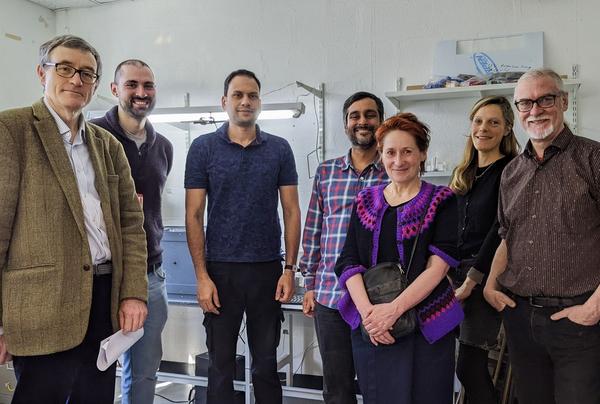After Queen Elizabeth II died in 2022, the papers reported that the palace beekeeper, John Chapple, had undertaken the traditional (Western) duty of telling the royal bees. This handed-down ritual involves telling the bees of major events in a household: a marriage, a christening, but most of all a death. It symbolically links the human domestic sphere with the world inside the hive, along the vector of an emotionally-loaded moment from the human world that the bees become included in the metabolism of.
This very same week, our project team had a reversal of this 'telling the bees' moment. The lab scientists came in to say that their queen had died, and they explained how that entire colony might now be unviable. As they answered our curious questions about buying new colonies on the internet, and how the queenless colony would behave, we noticed that the mood in the room had considerably dampened. We were sad to be told the news, and not exactly for scientific or Royalist reasons. Before working on this project I would have speculated a reason for our group response, but now I am more cautious, more aware that the most readily available answers will not always suffice: that our insights can be fine-tuned.
.jpg)
Our Leverhulme Trust-funded project, Bee-ing Human, has wanted to talk to and with bees, and to listen to them, particularly in relation to questions of emotion. We've taken an early modern book as our centrepiece: Charles Butler's A Feminine Monarchie, the title of which draws attention to the fact that he was focussing on the idea of a system with a female leader. First published in 1609, then in subsequent editions of 1623 and 1634, Butler's book is multi-modal. He kept bees, and writes with scientific precision about the practicalities of beekeeping. He's also a great storyteller, and knows how to turn his narrative dial between sharp first-person proof, to more incredulous second- or third-hand anecdote. In the middle of the book there is composed bee music, which again is situated somewhere between replicated and observed sounds, and impressionistic imitation. The text itself, through its punctuation, rhetoric and language, speaks in a variety of voices that create certain moods and movements.
We've been looking at how this book thinks with bees, and how the writing uses all these modes to move around the bees creating emotional insight.1 Its polyphony is a prompt and a challenge. The many elements of the book naturally worked together in Butler's mind, but in 2024 they are distributed between specialisms in the departments of the university. Revisiting Butler's book with a team representing the different strands of his thinking offers a unique chance to see how what we now call 'interdisciplinarity' works (as well as to produce the more concrete outcome of the project, a new Bee Book).
Working on and around Butler's book we have scientists, musicologists, literary scholars and digital humanists. Between us, we have a laboratory, rare books, choirs and expertise from across several disciplines. We've often sat together in the round discussing how we can take Butler's lead to think about bees, and how our different disciplines approach them as interlocutors, subjects, objects. What extra affordances or insight does this range of expertise supply? What has happened, during the project, in the interdisciplinary space between us?
Since we are already talking about queens, let us take the example of the queen bee. Let us imagine her flying around the boardroom in Newcastle where we have our project conversations, and see what happens to her in the space between us.
As she flies between us, she is at once a bee:
- In the Linnean sense, the entomological entity that scientists experiment on, and write articles about (and they would comment here that there are many different types of bee!).
- In the traditional sense, like the bees who were told of the Queen's death and have a narrative link, as bees, to the household, or to agricultural traditions.
- In the anthropomorphic sense, where allusions to historic queens get made and the bees are described as queens and princes themselves, for example the historical resonance between Butler's title and the lived memory of Elizabeth I in England (and an after-echo of Elizabeth II, for us).
- In the musical, vocal sense, as a dominant voice with its own patterns and sonic agency. And there are further divisions here: Animal and bird music can either be exactly imitative - a way of recording the sound - or it can be impressionistic, like the tunes made up in the 'voices' of birds from this time.
In the same vein, the project enables us to see all the different things 'emotion' can mean:
- The emotion-like states that Vivek and his lab are investigating, summarised here. These experiments, based on the ways that bees make choices when stressed, are looking into whether types of 'pessimism' and other feelings experienced by bees involve the kind of subjective feedback loop we'd expect to find in what is scientifically understood to be an emotional state.
- The role of bees in the broader interconnected affective world, and especially the anthropomorphised world, for instance, in a scenario like 'telling the bees', or in the relationship between the beekeeper and the bees that Butler writes about.
- The performance of emotion: the accreted cultural reference points that get used to describe how the bees behave, like the frameworks of the Amazons or the court.
- Musical and rhetorical conceptions or productions of emotion that are more to do with being 'moved' and affected by sound, pace, tempo, and which draw more directly on the etymological root of the word 'emotion'.
I cannot articulate fully the view that my colleagues, each with their discrete, careful scholarly systems, hold of the queen bee, but as a result of our collaboration I can feel the moments when she starts to fly into their territory. I can feel my view start to blur, as it were, or the language and truth-making systems of my own expertise and disciplinary standpoint start to run thin, and that is the moment when it becomes necessary to draw in a colleague from another field. The queen flies over to them and they pick up the task of describing her in a different light.

What does the queen look like as she flies between us?
In the humanities the idea of the king's or queen's 'two bodies' has been very influential, and I think it may be useful here. First written about by Ernst Kantorowicz and taken up by Michel Foucault, this seam of scholarship showed that in political and cultural history the monarch had their natural physical body and their political body, and that in some cases these constituted two different agencies (hence 'two bodies'). The polyphonic structure of our group let us see the queen bee's various bodies and identities across narrative modes and disciplinary forms of enquiry. She is not simply the physical body of the lab, nor the analogical body of an Amazon, nor the musical voice of the seventeenth-century score. She is all of them. What Butler's book instinctively perceives, we can confirm and add great texture to.2
The original 'two bodies' idea differentiated the monarch's different agencies, and outlined how different systems governed each, but it never suggested that these systems should be considered unlinked. On the contrary, it highlighted what an extraordinary person the monarch was, composed of several identities that operated on different vectors. Interdisciplinarity as I have described it above gives us the chance to see any subject in such a rich light. Moments of apparent incommensurability become signs that our subject is about to shapeshift again. Different disciplinary metric systems become a very useful set of dials that can bring the subject of inquiry into focus.
In our project, those dials look like:
- Results from laboratory experiments, produced and reported according to the language and conventions of contemporary science journals and funding bodies.
- Editing and collation of the differences between Butler's 1609 and 1623 editions, to show how his thinking changes, using traditional scholarly methods and new digital tools such as TEI.
- Historical and cultural contextualisation of the references and internal world of the bee book.
- Choral interpretation and performance of the musical score in Butler's book.
We are bringing our expertise into dialogue most acutely in our annotation of chapter 5, the central chapter of the book, where our glosses enrich Butler's text. This is innovative. You might usually find a chapter annotated by one scholar who was attempting to have an expansive and interdisciplinary approach, but here we are annotating this chapter as a group, talking to Butler closely side-by-side.
The example I chose here didn't need to be the queen bee: it could just as well have been a swarm, or Butler himself. We can let the queen go now, but shall we take her back to the lab, or let her out of the window, or give her back to her court, or replace her in the particular musical staves of the early-modern printer, or nestle her in the digital mark-up of our edited text? All of them, because she belongs in all these places.
- c.f. Terence Cave's Thinking With Literature.↩
- The variety of positions also highlights which parts of our project are localised to Western traditions and which aren't. Butler's book is written from within his British (or at least European) context, and the musical principles of his composition are too. Whereas the science of emotion-like states is expecting its insights to be more global in reach. In terms of our seventeenth-century book, we are aware of the nuances of how Butler's emotional schema fits on to his local cultural references.↩
